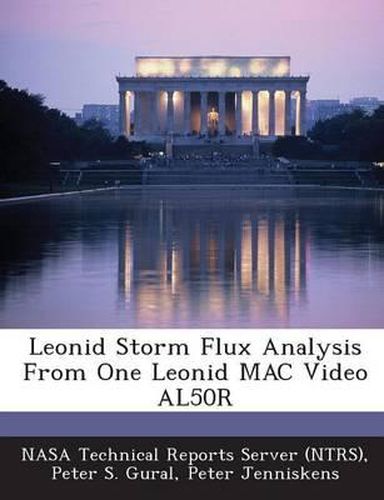Readings Newsletter
Become a Readings Member to make your shopping experience even easier.
Sign in or sign up for free!
You’re not far away from qualifying for FREE standard shipping within Australia
You’ve qualified for FREE standard shipping within Australia
The cart is loading…






A detailed meteor flux analysis is presented of a seventeen-minute portion of one videotape, collected on November 18, 1999, during the Leonid Multi-instrument Aircraft Campaign. The data was recorded around the peak of the Leonid meteor storm using an intensified CCD camera pointed towards the low southern horizon. Positions of meteors on the sky were measured. These measured meteor distributions were compared to a Monte Carlo simulation, which is a new approach to parameter estimation for mass ratio and flux. Comparison of simulated flux versus observed flux levels, seen between 1:50:00 and 2:06:41 UT, indicate a magnitude population index of r = 1.8 +/- 0.1 and mass ratio of s = 1.64 +/- 0.06. The average spatial density of the material contributing to the Leonid storm peak is measured at 0.82 +/- 0.19 particles per square kilometer per hour for particles of at least absolute visual magnitude +6.5. Clustering analysis of the arrival times of Leonids impacting the earth’s atmosphere over the total observing interval shows no enhancement or clumping down to time scales of the video frame rate. This indicates a uniformly random temporal distribution of particles in the stream encountered during the 1999 epoch. Based on the observed distribution of meteors on the sky and the model distribution, recommendations am made for the optimal pointing directions for video camera meteor counts during future ground and airborne missions.
$9.00 standard shipping within Australia
FREE standard shipping within Australia for orders over $100.00
Express & International shipping calculated at checkout
A detailed meteor flux analysis is presented of a seventeen-minute portion of one videotape, collected on November 18, 1999, during the Leonid Multi-instrument Aircraft Campaign. The data was recorded around the peak of the Leonid meteor storm using an intensified CCD camera pointed towards the low southern horizon. Positions of meteors on the sky were measured. These measured meteor distributions were compared to a Monte Carlo simulation, which is a new approach to parameter estimation for mass ratio and flux. Comparison of simulated flux versus observed flux levels, seen between 1:50:00 and 2:06:41 UT, indicate a magnitude population index of r = 1.8 +/- 0.1 and mass ratio of s = 1.64 +/- 0.06. The average spatial density of the material contributing to the Leonid storm peak is measured at 0.82 +/- 0.19 particles per square kilometer per hour for particles of at least absolute visual magnitude +6.5. Clustering analysis of the arrival times of Leonids impacting the earth’s atmosphere over the total observing interval shows no enhancement or clumping down to time scales of the video frame rate. This indicates a uniformly random temporal distribution of particles in the stream encountered during the 1999 epoch. Based on the observed distribution of meteors on the sky and the model distribution, recommendations am made for the optimal pointing directions for video camera meteor counts during future ground and airborne missions.